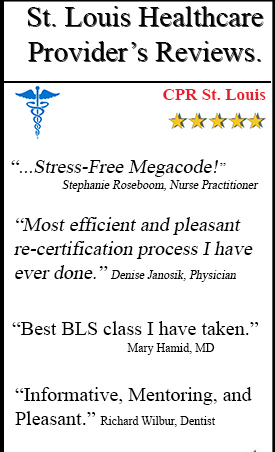Congestive Heart Failure (CHF) by Chuck Wensler
Call Us Now
Get the Best CPR Class in St. Louis Today!
Heart Failure is a condition where the heart is unable to pump enough oxygen and nutrient-rich blood to meet the body’s demands for normal tissue functioning. In the early stages, the heart will compensate and respond by enlarging to hold more blood with an increase in muscle tissue and a faster pumping action while combining this with vasoconstriction to increase pressure. Eventually, these compensations fail as the chamber walls of the heart become rigid and thick and the muscle walls become weaker. When the pumping action of the heart becomes damaged or weakened, blood can begin to accumulate in various areas of the body. The increased pressure created from this build-up of blood forces fluid out of the blood vessels and into tissue, causing edema, and becomes Congestive Heart Failure.
Congestive Heart Failure, or CHF, can affect either the right or left side of the heart resulting in right or left-sided ventricular heart failure. However, both sides are more commonly affected. Left-sided heart failure tends to result in congestion in the lungs or pulmonary edema. Breathing becomes more difficult as the fluid buildup prevents proper airway expansion upon inhalation. The two types of left-sided heart failure are Systolic and Diastolic. Systolic failure means the left ventricle can no longer contract with enough force to pump all the blood needed into circulation. Diastolic failure occurs when the muscle has become too rigid to properly relax after a contraction, not allowing enough blood to flow in within the resting period.
Right-sided ventricular heart failure, when present, generally develops as a result of the left-sided heart failure’s damage to the lungs which then damages the right ventricle. This is associated with extra fluid collection in the feet and lower legs, resulting in pitted edema. Pitted edema from congestive heart failure is characterized by an indentation being left when a fingertip is pressed down on the swollen leg or ankle. This swelling if left untreated can eventually move to the upper legs and abdomen.
CHF is a syndrome that is usually provoked by a primary heart or vessel problem or more commonly a combination of these. Some hidden or underlying causes of congestive heart failure include coronary artery disease which could lead to myocardial infarction, uncontrolled high blood pressure which thickens the heart muscle and damages blood vessels, heart valve disorders, cardiomyopathy, and arrhythmias. Less common causes such as viruses, infections, thyroid or congenital disease as well as exposure to toxins could also play a role. Unwise or unhealthy lifestyle choices such as smoking, excessive alcohol consumption, obesity, and sedentary habits and the secondary high blood pressure, diabetes, and coronary artery disease that follow could also be considered as causes.
Some earlier signs of CHF include a persistent cough and fatigue. These will gradually get worse, although they can suddenly become severe. Swelling of the feet and ankles with pitted edema along with a noticeable shortness of breath from accumulation of fluid in the lungs are very common, and some find the breathlessness worse while laying down and begin to sleep upright. Increased urination, especially at night, along with nausea, abdominal pain, and lack of appetite can all be experienced as well.
Treatments for heart failure include many nonpharmacologic, pharmacologic, and invasive strategies that may limit and reverse heart failure. Depending on the severity of the illness, nonpharmacologic therapies include dietary changes, physical activity, and attention to weight gain. Pharmacologic therapies may include the use of diuretics, vasodilators, anticoagulants, beta-blockers, as well as other assortments of pharmaceuticals. Other therapies for heart failure include electro-philologic intervention such as cardiac resynchronization therapy, pacemakers, and implantable defibrillators; procedures such as coronary artery bypassing grafting and percutaneous coronary intervention; valve replacement or repair; and ventricular restoration. When the prognosis is poor and progressive end-stage heart failure occurs despite maximal medical therapy, with no viable therapeutic alternative, the only other option would be heart transplantation. However, mechanical circulatory devices such as ventricular assist devices and total artificial hearts can bridge the patient to transplantation.
References
Heart Failure (2011). Pub Med NCBI National Institute of Health. Retrieved on December 3, 2011 from: https://www.ncbi.nlm.nih.gov/pubmedhealth/PMH0001211/
Congestive Heart Failure (2011). eMedicinehealth. Retrieved on December 3, 2011 from: https://www.emedicinehealth.com/congestive_heart_failure/page3_em.htm
About Heart Failure (2011). American Heart Association. Retrieved on December 3, 2011 from: https://www.heart.org/HEARTORG/Conditions/HeartFailure/AboutHeartFailure/About-Heart-Failure_UCM_002044_Article.jsp






